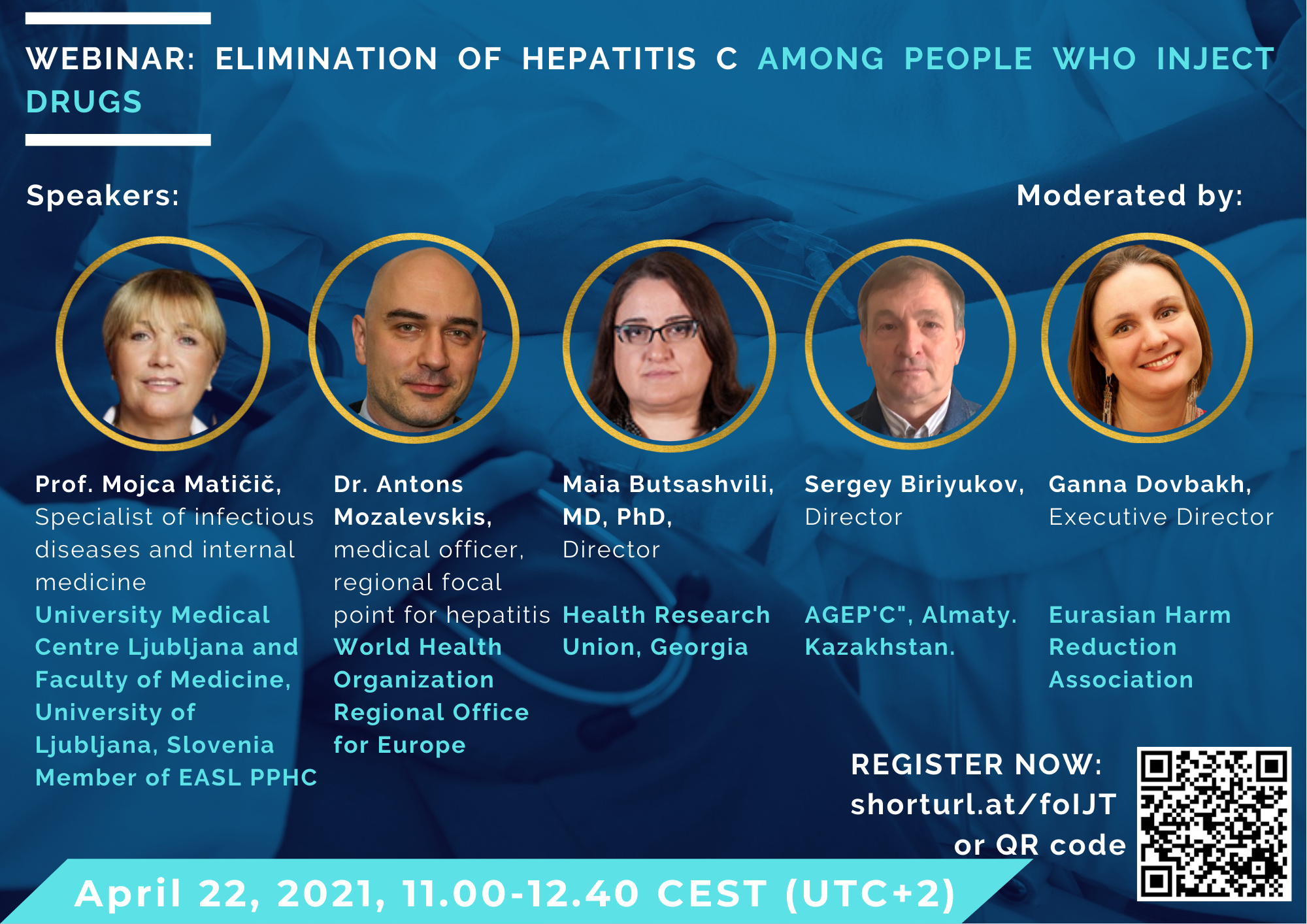The webinar
The webinar is organized by the Eurasian Harm Reduction Association (EHRA) in partnership with the European Association for the Study of the Liver (EASL), the World Health Organization Regional Office for Europe(WHO/Europe).
Date, time:
April 22, 2021, 11.00-12.40AM CEST (UTC +2)
Platform:
ZOOM, English-Russian simultaneous translation.
Moderator:
Ganna Dovbakh, EHRA
Participants:
Medical experts and practitioners on hepatitis C treatment from countries of Eastern Europe and Central Asia region.
Language:
English and Russian with simultaneous translation.
REGISTER NOW HERE
Background
The prevalence of viral hepatitis C among people who inject drugs is very high in the Eastern Europe and Central Asia region and varies from 15 up to 94%.[1]The WHO Global Health Sector Strategy on Viral Hepatitis sets the goal of eliminating hepatitis C as a public health threat by 2030[2]and it has been recognized that this goal cannot be achieved without addressing HCV-infection among people who inject drugs. The barriers to effective response to HCV among people who inject drugs include restrictive drug policies, poor access to cost-efficient[3] harm reduction services, low hepatitis C testing, linkage to care and treatment, restrictions for accessing direct‐acting antiviral (DAA) therapy and the lack of national strategies and government investment to support WHO elimination goals[4].
[1] Harm Reduction International (2020). Global State of Harm Reduction. Global Overview 1.3 Hepatitis C. pp48. URL: https://www.hri.global/files/2020/10/26/Global_State_HRI_2020_1_3_Hepatitis_C_FA.pdf
[2] https://www.who.int/hepatitis/strategy2016-2021/ghss-hep/en/
[3] Mabileau G. et al. Intervention Packages to Reduce the Impact of HIV and HCV Infections Among People Who Inject Drugs in Eastern Europe and Central Asia: A Modeling and Cost-effectiveness Study, Open Forum Infectious Diseases, Volume 5, Issue 3, March 2018, ofy040, https://doi.org/10.1093/ofid/ofy040
[4] Day E, Hellard M, Treloar C, et al. Hepatitis C elimination among people who inject drugs: Challenges and recommendations for action within a health systems framework. Liver Int. 2019;39(1):20-30. doi:10.1111/liv.13949
Objectives of the webinar
- to update clinicians treating patients with hepatitis C (e.g. hepatologists and infectious disease specialists) and clinicians working with people who inject drugs(e.g. addiction specialist, narcologists and prison doctors) on situation with hepatitis C among people who inject drugs, including barriers in access to treatment and care;
- to present latest WHO and EASL recommendations, including EASL policy statement on drug use in the context of the global hepatitis C elimination goal;
- to share good practices in hepatitis C response among people who inject drugs from countries of EECA.
Agenda
|
April 22, 2021, 11.00-12.40 AM CET |
||
| Time | Title | Speaker/facilitator |
| 11.00-11.05 | Introduction, objectives of the webinar. | Ganna Dovbakh, EHRA |
| 11.05-11.20 | Hepatitis C among people who inject drugsin EECA. WHO recommendations | Dr.Antons Mozalevskis, WHO/Europe |
| 11.20-11.45 | The global hepatitis C elimination goal and EASL recommendations for a complex management of HCV in people who inject drugs | Prof. Dr Mojca Matičič, EASL |
| 11.45-11.55 | Regional overview on barriers in access to treatment and care in EECA | Ganna Dovbakh, EHRA |
| 11.55-12.15 | Country experience | Dr Maia Butsashvili, Georgia
Sergey Biriyukov, Kazakhstan |
| 12.15-12.35 | Interactive discussion session with the webinar participants | Ganna Dovbakh, EHRA |
| 12.35-12.40 | Conclusions and closing of the webinar | Ganna Dovbakh, EHRA |


